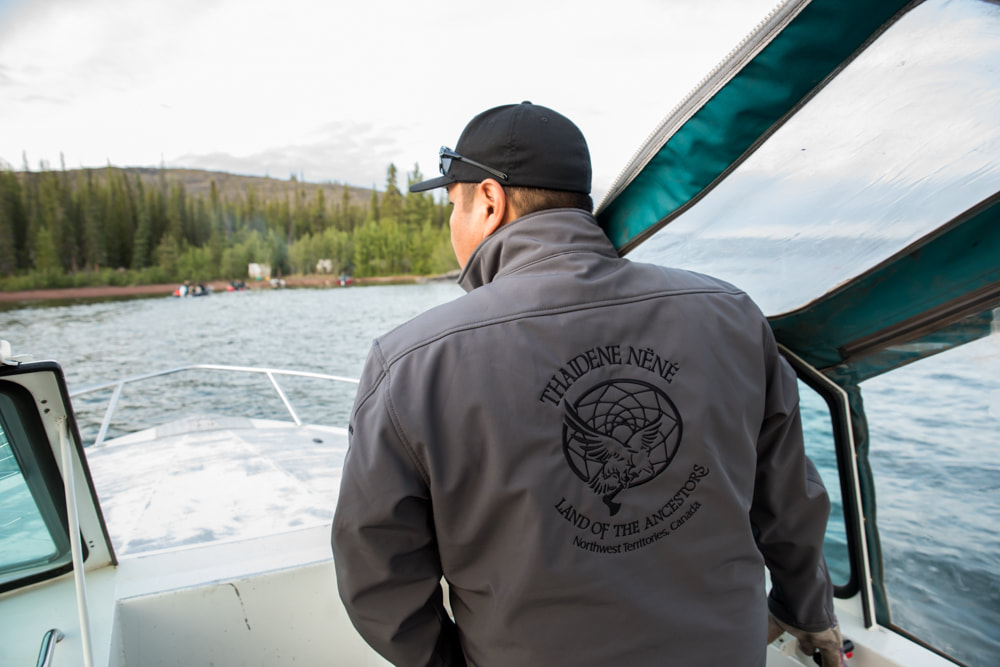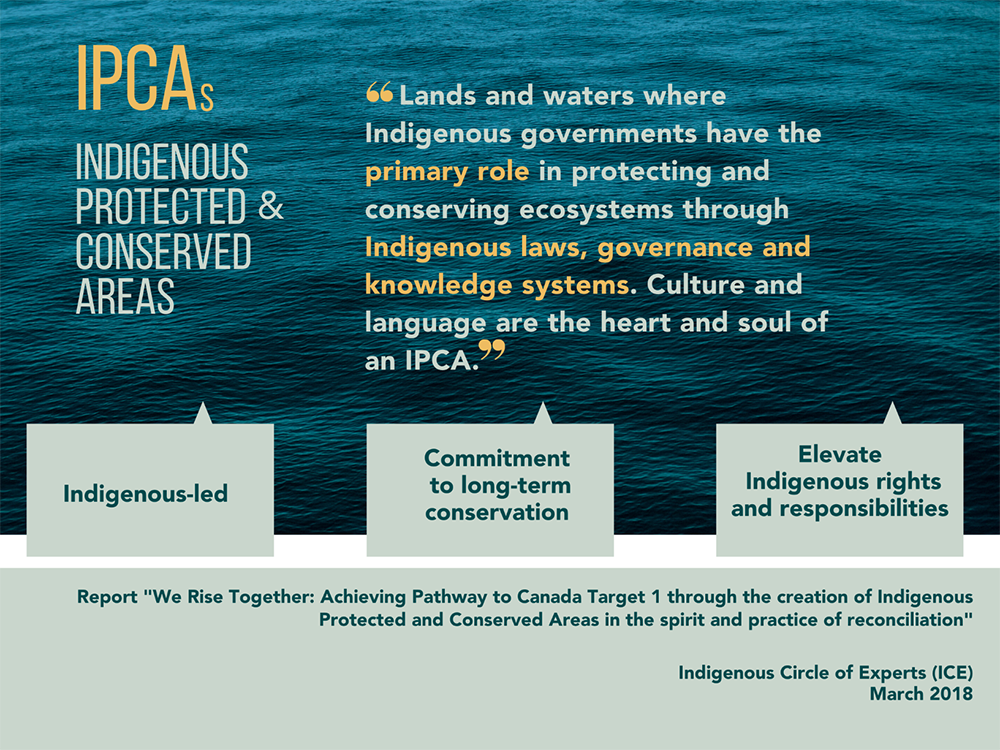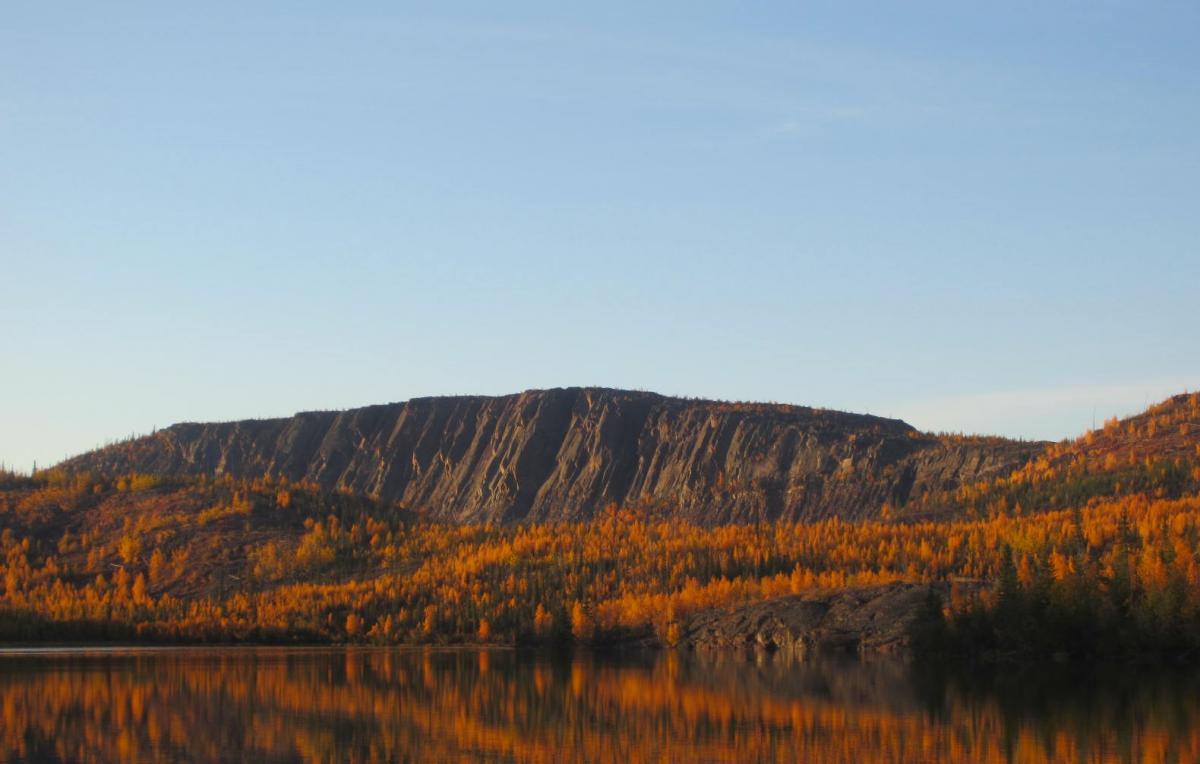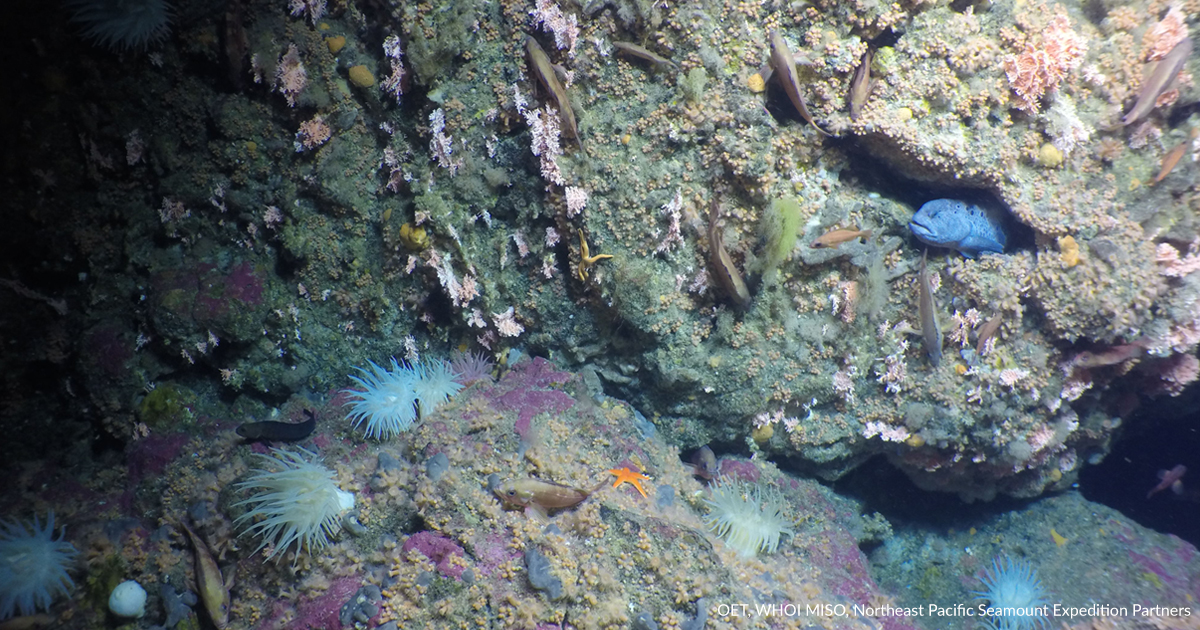
“Our ancestors knew that their survival depended on clean water and taking only what was needed. Indigenous peoples lived by the natural laws of the land and waters, and that allowed our societies to thrive.” - Bev Sellars, Elder and former chief, Xat’sull Nation
Many scientists now agree with what Indigenous societies have long understood: in order to avoid catastrophic climate change, maintain healthy habitats and secure the vital ecosystem services that sustain us, we must protect much of the land and water in a given region, and live more lightly on the Earth. A growing movement of Indigenous conservation initiatives including Indigenous Protected and Conserved Areas (IPCAs) and Indigenous Guardians programs are working to restore relationships and responsibilities between Indigenous peoples and their lands as a critical step towards sustainability.
These initiatives are grounded in Indigenous laws and knowledge systems that go back to the beginning of time by Indigenous societies that maintain long-standing relationships and responsibilities to their lands and waters. As the interconnected climate and ecological crises deepen, IPCAs can serve as places of refuge to curb biodiversity loss and as buffers in the face of a drastically changing climate. They can also demonstrate the leadership that all Canadians require to meet these global challenges.

© 2020 Legal Atlas LLC, based on information from West Coast Environmental Law
Indigenous laws in conservation
Indigenous laws, governance and knowledge systems are the foundation of Indigenous Protected and Conserved Areas (IPCAs). Long before Canada was a country, Indigenous peoples lived under their own laws. A century or more of colonization has altered much of the landscape, and public governments (the Crown) have not recognized or respected Indigenous laws and jurisdiction in a meaningful way.
But this may be changing. The Government of Canada has committed to protect 30 percent of the land and waters by 2030 to contribute to international conservation targets. As part of this target, the Canadian government has a mandate to support Indigenous-led conservation initiatives and has committed to upholding Nation-to-Nation and Crown-to-Inuit relationships, including recognizing Indigenous jurisdiction and laws.
Crown governments are increasingly acknowledging that their protected area targets and constitutional obligation cannot be met without the support and consent of Indigenous nations. As the Honourable Murray Sinclair explains,
“Canada can become an environmental leader by becoming an Indigenous rights leader.”
This creates an opportunity for Crown and Indigenous governments to come together in ethical spaces to establish and govern IPCAs grounded in both Indigenous and Crown laws and knowledge systems. The question is how?
In this report, produced through the Conservation through Reconciliation Partnership, we examine how Indigenous and Crown laws can operate alongside one another in IPCAs based on mutual recognition and respect.
The study focuses on some leading examples of where this is occurring: SGaan Kinghlas-Bowie Seamount Marine Protected Area in Haida Gwaii and Thaidene Nëné in Łutsël K’é Dene First Nation territory.
The backdrop: Canada is a multi-juridical country
The term "Indigenous law” refers to Indigenous peoples’ own law. This is in contrast to the term “Aboriginal law,” which refers to Canadian law as it applies to Indigenous peoples.
The source of Indigenous jurisdictions and authority over lands and resources arises from the fact that Indigenous nations existed as distinct peoples on their own lands and lived under their own laws long before Canada. And they continue to exist as nations today.
Indigenous laws are distinct legal orders that operate concurrently with the common law and civil law in Canada. This is not a novel concept. The recognition of Indigenous nations and Indigenous laws was fundamental not only to the formation of the first pre-Confederation treaties, but was a necessary fact for enabling European settlements and trading relationships to be established in what is now Canada.
Canada has always been a multi-juridical society, meaning there are multiple legal systems operating concurrently. This is reflected not only in the pre-Confederation era, but also in the very design of the federation. A clear example is that both English and French languages and legal traditions have been integrated into Canada’s legal and political orders.
However, over the past 150 years, the dominant direction of Crown governments and the Canadian courts was to deny or exclude Indigenous law. Crown governments deliberately ignored and oppressed Indigenous laws in an attempt to replace them with colonial law.
Concepts such as the Doctrine of Discovery and terra nullius were used by the Crown to justify European sovereignty over Indigenous peoples and lands. The systematic displacement of Indigenous peoples from their territories, communities, languages, cultural practices, institutions and governance caused serious damage to Indigenous legal orders.
Until recently, Crown legislation and authority were used coercively to force Indigenous peoples off of their lands, and undermine their traditional stewardship and governance roles over those places. IPCAs represent an important evolution in the way Euro-Canadians have traditionally thought about parks and protected areas. Rather than seeing them as places “protected from people,” they are considered places “protected for people.”
This is a significant shift. The conservation movement in Canada has historically viewed parks and other protected areas as opportunities to create “pristine” areas removed from human influence, or to turn them into “playgrounds” for outdoor recreation and other pursuits, rather than understanding those areas as critical parts of Indigenous cultural landscapes.
In contrast, IPCAs are explicitly committed to the conservation of ecological and cultural values that are important to Indigenous peoples. IPCAs can also:
- Promote respect for Indigenous knowledge systems;
- Respect protocols and ceremony;
- Support the revitalization of Indigenous languages;
- Seed conservation economies (where possible);
- Conserve cultural keystone species and protect food security; and
- Adopt integrated, holistic approaches to governance and planning.
Indigenous laws vary from nation to nation, and so does the vision for how they are being revitalized and applied in a modern context. It is fundamentally a matter of self-determination for each Indigenous nation to identify what form of IPCA they may wish to pursue.
Two Case studies: Mutual recognition of Crown and Indigenous laws
Thaidene Nëné
 Thaidene Nëné is a jointly established IPCA within 26,376 square kilometres of Dënesųłıné territory that encompasses boreal forest, tundra, and freshwater ecosystems in what is now the Northwest Territories. Literally described as the “Land of the Ancestors,” Thaidene Nëné has sustained the Łutsël K’é Dënesųłıné for generations.
Thaidene Nëné is a jointly established IPCA within 26,376 square kilometres of Dënesųłıné territory that encompasses boreal forest, tundra, and freshwater ecosystems in what is now the Northwest Territories. Literally described as the “Land of the Ancestors,” Thaidene Nëné has sustained the Łutsël K’é Dënesųłıné for generations.
The area was identified as a potential national park in the late 1960s by the federal government. However, the Łutsël K’é Dene First Nation did not support the idea of a national park on their traditional territory, as it would exclude them from using the area for traditional purposes.
In 2000, after significant evolutions in the dynamics of the relationship between Indigenous peoples and the federal government – and under the threat of expanded mineral and hydro development in the area – Chief Felix Lockhart of Łutsël K’é Dene First Nation declared the area to be protected under Łutsël K’é authority. Łutsël K’é approached the Canadian government to renew discussions about jointly establishing Thaidene Nëné as a national park.
In 2020, establishment agreements between the Government of the Northwest Territories (GNWT), Parks Canada, and Łutsël K’é Dene First Nation were finalized to designate Thaidene Nëné as a jointly established IPCA: as a federal National Park Reserve and as a Territorial Park under territorial legislation. Dene legal principles of equality and reciprocity are woven throughout the Agreements, which establish a decision-making body called Thaidene Nëné xá dá yáłtı (“those who speak for Thaidene Nëné”).
All decisions of Thaidene Nëné xá dá yáłtı are made by consensus, meaning one party cannot act without the consent of the other.
SGaan Kinghlas- Bowie Seamount Marine Protected Area
 Since the 1980s, the Haida Nation has been creating Haida Heritage Sites designated under Haida law to protect key areas within Haida territory.
Since the 1980s, the Haida Nation has been creating Haida Heritage Sites designated under Haida law to protect key areas within Haida territory.
The Haida Nation has partnered with the Governments of Canada and British Columbia to protect some of these areas as Crown protected areas (e.g. Gwaii Haanas Haida Heritage Site, National Park Reserve, and National Marine Conservation Area Reserve). These collaborative arrangements are based on joint jurisdiction of the Haida Nation and the Crown.
In the various establishment agreements, the Haida Nation and Crown governments ‘agree to disagree’ about underlying sovereignty to the protected areas and instead focus on their shared interest of conserving these unique areas.
SGaan Kinghlas-Bowie Seamount is an ancient underwater volcano located 180 kilometres offshore of Haida Gwaii. According to Haida oral histories (gin k’iiygangaas), the seamount is home to SGaan Kinghlas, a supernatural being whose name means “Supernatural being looking outwards.” The Haida have an intimate interconnection with supernatural beings, who inhabited the earth before the time of humans.
The Haida Nation and the Government of Canada signed an agreement in 2007 committing the two nations to manage this special place together, in “a relationship based on mutual respect and understanding.” Following the agreement, the site was designated as a federal marine protected area (MPA) under the Oceans Act in 2008.
The SGaan Kinghlas-Bowie Seamount MPA Management Board consists of two representatives from the Council of the Haida Nation (CHN) and two representatives from Fisheries and Oceans Canada (DFO). The Management Board seeks to operate by consensus and makes recommendations to the CHN and DFO for their final decisions.
The planning of the SGaan Kinghlas-Bowie Seamount MPA are based on six guiding principles reflected in Haida ethics, values, and laws:
- Yahgudang (respect);
- Gin’laa hl isdaa.uu. (responsibility);
- Gin ‘waadluwaan gud ahl k waagiidang (interconnectedness);
- Gin’waadluwaan damaan tl’kinggang (balance);
- Gin k’aaydaangga Giiy uu tl’a k’anguudangs (seeking wise counsel);
- and ‘Isda isghyaan diigaa isdii (giving and receiving).
As Haida lawyer, gid7ahl-Gudsllay Terri-Lynn Williams-Davidson explains, “These values underpin Haida laws and are reflected in them.” In other words, through the inclusion of these guiding principles, Haida laws and ethics play a major role in shaping and guiding the establishment and management of the SGaan Kinghlas-Bowie Seamount MPA.
Safeguarding the SGaan Kinghlas – Bowie Seamount Marine Protected Area (Video from Fisheries & Oceans Canada)
Concluding Reflections
IPCAs offer a pathway for the Crown to recognize and affirm Indigenous laws and governance. They provide opportunities to develop new institutions for reconciling Crown and Indigenous laws and decision-making in the establishment of new protected areas.
Mutual recognition of Indigenous and Crown jurisdictions throughout the establishment, management and operation of IPCAs can advance effective conservation and provide a pathway for reconciliation. IPCAs offer clear and compelling benefits for both Indigenous and Crown governments that go well beyond conservation.
Indigenous law is now being recognized and realized in Canada through a growing body of legal decisions, legislative changes, modern treaties and other constructive agreements between Indigenous peoples and public (or Crown) governments. IPCA establishment is just one way in which Indigenous laws are being recognized and affirmed in Canada today, but they are having a significant and positive impact on conservation.
As the establishment of Thaidene Nëné and SGaan Kinghlas-Bowie Seamount demonstrate, the recognition of Indigenous law and shared decision-making substantially reduces conflicts and fosters relationships that advance mutual learning and effective decision-making. These elements are increasingly critical for addressing present and future challenges in conservation.
Indigenous nations will continue to establish IPCAs as spaces to actively govern their territories and implement and pass on their knowledge and laws to future generations. It is now up to Crown governments to make the necessary changes in their own policies to enable IPCAs to become a part of their own pathway to conservation and reconciliation.
Top photo: Thaidene Nëné, Land of the Ancestors (Credit - Pat Kane)
Thaidene Nëné photo: Christie Bay (Credit - Łutsël K’é Dene First Nation)
SGaan Kinghlas-Bowie Seamount photo: Marine life at SGaan Kinghlas-Bowie Seamount (Credit - Ocean Exploration Trust/Northeast Pacific Seamount Expedition Partners)